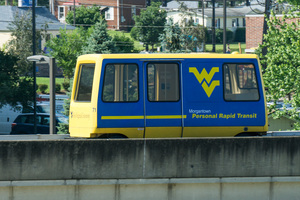 | Back to e-WV
| Back to e-WV
 The West Virginia Encyclopedia
The West Virginia Encyclopedia
 | Back to e-WV
| Back to e-WV
 The West Virginia Encyclopedia
The West Virginia Encyclopedia

The Personal Rapid Transit (PRT) commuter system connects Morgantown’s downtown business district, the West Virginia University downtown campus, WVU Evansdale campus, WVU’s residence halls, and the WVU medical center. The first fully automated urban guide-way transit system, it was conceived by the WVU College of Engineering during the 1960s in response to national discussions of traffic congestion. Phase I of the project was completed in 1975. Phase II, which expanded and improved the system, was completed in 1979.
The PRT consists of five passenger stations, 69 electronically powered vehicles, 8.7 miles of guide-ways, and maintenance facilities. Passengers use turnstiles that take coins or a PRT card, and the cars are controlled at the computer center; there are no station or vehicle operators. Each vehicle can carry eight seated and 12 standing passengers and can travel up to 30 miles per hour. The speedy blue-and-gold cars run on rubber wheels in a U-shaped concrete guide-way, with power and signal rails along the guide-way wall. At peak capacity, the system can transport 1,100 people in 20 minutes. It transports about 15,000 students per day and has carried more than 80 million passengers since opening in 1975.
In addition to being a unique part of the WVU student experience, the PRT has had a lasting impact on public transportation. It is a valuable research tool, allowing fast data collection in five peak periods per day. It has proven itself on hilly terrain, and in weather ranging from sun to fog to snow and ice. The first transportation system to model itself after the PRT was the Kobe Rapid Transit System in Japan, and there are other automated commuter systems in Detroit, Jacksonville, Miami, and Irving, Texas.
Written by Elizabeth Ann H. McClain and W. Russ McClain